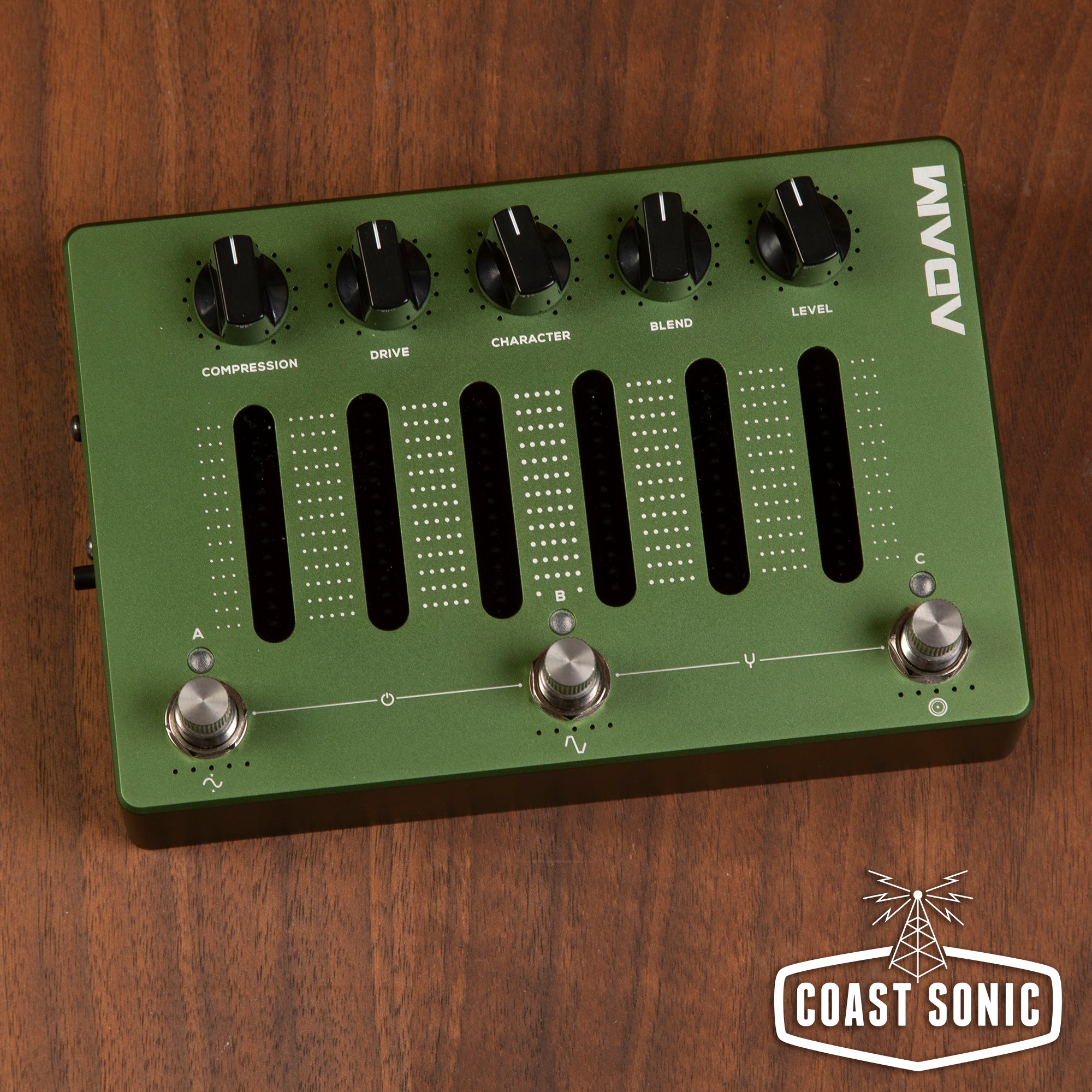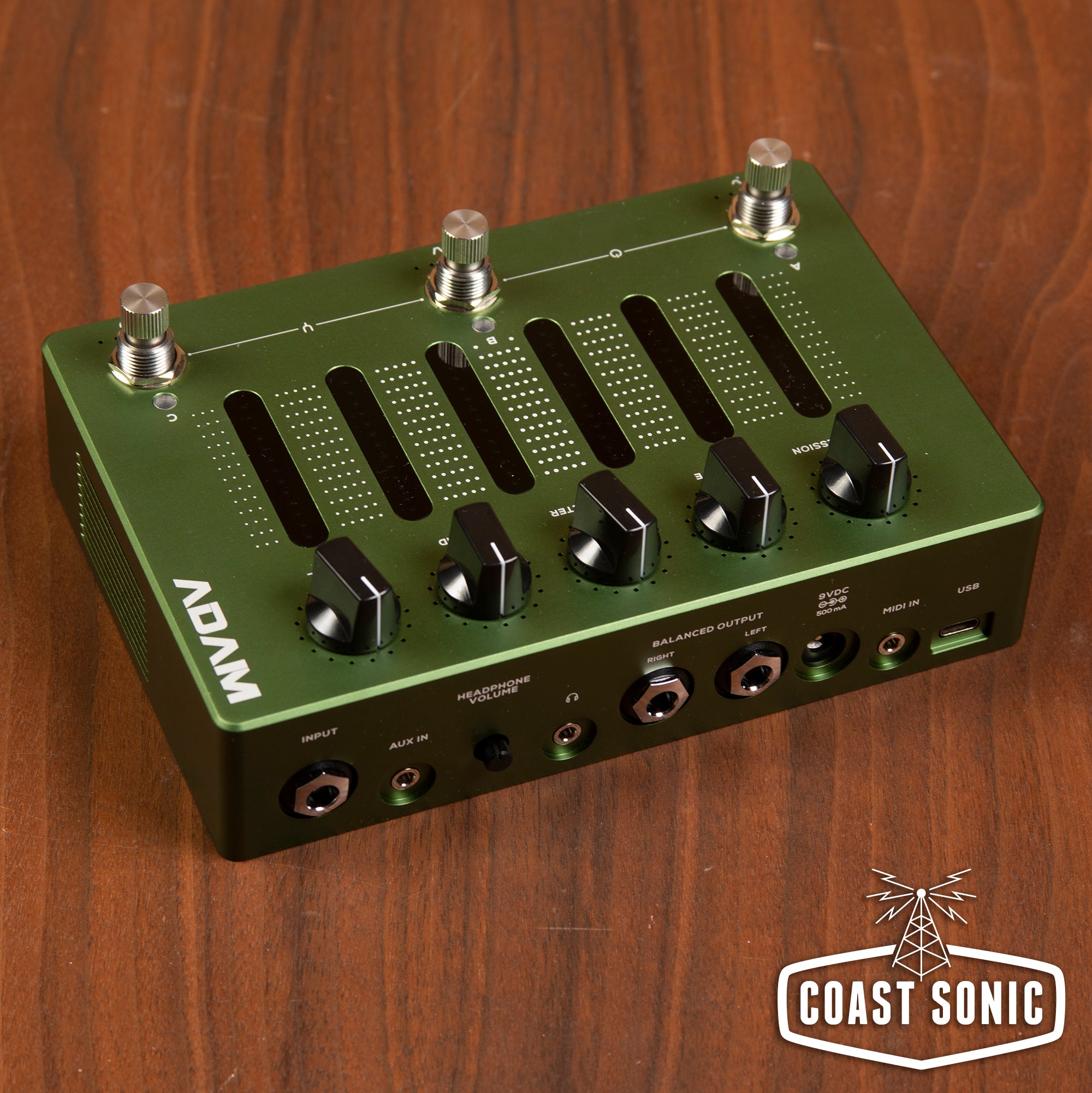Darkglass Electronics ADAM
Couldn't load pickup availability
Maker: Darkglass Electronics
Model: ADAM
Condition: New
Description:
ADAM has three fully programmable rotating footswitch presets. Each of these stores your unique blend of compression, distortion, impulse responses, EQ parameters, and signal chain settings. Featuring a unique and innovative top-notch precision touch slider interface, for its 6-band programmable EQ.
It also incorporates a USB-C audio interface and balanced stereo outputs for studio monitors and is equipped with an extra accurate chromatic tuner, that also works well with down-tuned guitars and basses.
Features
Compression
Controls the amount of input gain to the compressor and intelligently applies the correct amount of makeup gain so that your signal is always driven at the appropriate level, no matter how much compression is applied.
Drive
Adds distortion and drive to your signal. Crank this knob to apply Nolly’s favorite vintage distortion to the distorted part of the signal chain.
Character
Changes the tone of the distortion, adding brightness to the distortion signal.
Blend
Mixes between the distortion signal and the clean sidechain signal
Level
Controls the master volume of ADAM.
Touch Sensitive Sliders
Each slider has a -12 dB to 12 dB range. From left to right, the frequency bands for each slider correspond to a low shelf, 250 Hz, 500 Hz, 1.5 kHz, 3 kHz, and a high shelf.
Input
This is the primary instrument input on ADAM. Connect your instrument or output from your pedal board to the 1/4” mono jack.
Aux In
The stereo input of ADAM enables the playback of backing tracks while practicing or recording. Connect your mobile phone, laptop etc. to the 1/8” stereo jack.
Headphone Output
The headphone output can handle headphones with an impedance of 16 - 600 ohms. Connect your headphones to the 1/8” stereo jack and set the desired level from the dedicated potentiometer next to the jack.
Balanced Outputs
The two balanced outputs add routing versatility and the option of using ADAM as a fully equipped audio interface.
Direct Output
An XLR output with a ground lift switch provides a reliable standard connection to a mixing desk or an external audio interface for a guaranteed low-noise signal.
MIDI In
A standard 1/8” TRS jack allows connecting an external MIDI controller to ADAM for even more flexibility.
USB
The USB-C port unlocks ADAM’s USB audio interface capabilities and enables interaction with the Darkglass Suite desktop app, allowing for software updates and access to the Darkglass IR library, containing hundreds of cabinet simulations.
DIMENSIONS
18*12*6 cm | Weight 0.7 kg
WARNING
The ADAM has a current draw of 500mA. Only use a regulated 9V DC adapter with a center-negative plug. Due to ecological reasons, it does not accept batteries. Unregulated power supplies and/or higher voltages may result in suboptimal noise performance and even damage your unit, voiding the warranty
MIDI specification for ADAM FW v1.0
With ADAM’s MIDI input, you can change between your saved presets and update the smart potentiometers, touch sliders, and encoders.
ADAM responds to MIDI messages from all channels, so you do not have to otherwise specify a MIDI channel to use ADAM’s MIDI input functionality.
To change the parameters of ADAM, you must send MIDI control change messages. These are mapped to ADAM’s parameters as follows:
0 to 4: Smart potentiometers from Compression to Level, left-to-right
5 to 10: Touch-sensitive sliders, left-to-right
11 to 13: Encoder rotation setting, left-to-right
The value of the control change message (0 to 127) is mapped across each of these controls.
For example, a control change 3 message with value 64 would set the Blend potentiometer halfway, and a control change 10 message with value 0 would move the high shelf EQ band to -12 dB.
To change between ADAM’s presets, you must send MIDI program change messages. The program change number will always map to presets A, B, or C.
Please note that these specifications are subject to change in future firmware updates.
Audio routing specification for ADAM FW v1.0
ADAM has four ways to receive audio: Instrument in, Aux in, Bluetooth, and USB output from your DAW when used as an interface.
ADAM has four ways to output audio: a stereo balanced output pair, stereo headphones, a direct XLR output, and USB input to your DAW when used as an interface.
Please note that the routing is subject to change in future firmware updates.
USB routing
ADAM supports 48 kHz and 44.1 kHz sampling rates.
USB output (to ADAM)
Output 1: Balanced left + Headphone left
Output 2: Balanced right + Headphone right
Output 3: Balanced left
Output 4: Balanced right
Output 5: XLR DI (mono)
Both Mac and PC send system audio to outputs 1 and 2 by default, so you can always use ADAM’s stereo output of choice without having to set up any extra routing. The level of these outputs is controlled by the small volume potentiometer at the top of ADAM. The other outputs have no volume control on ADAM.
USB input (from ADAM)
Input 1: Processed signal (unprocessed signal if bypassed)
Input 2: Unprocessed raw signal
Input 3: Aux left + Bluetooth left
Input 4: Aux right + Bluetooth right
Audio routing
When ADAM is not bypassed, the Level potentiometer always controls the volume of your instrument input at all four outputs, and has no effect on the USB/Aux/Bluetooth audio. When ADAM is bypassed, the Level potentiometer has no effect.
Your instrument, Aux input, and Bluetooth audio is routed to the headphone and balanced outputs. The media volume at these outputs can be controlled with the small potentiometer at the top of ADAM.
- When using the balanced outputs, the media volume and instrument volume level are separately controlled (small volume potentiometer at the top of ADAM and the Level potentiometer, respectively).
- When using headphones, the volume is controlled in the same way, with one exception: the headphone volume potentiometer acts as an overall master volume for both media and your instrument input.
- The XLR DI output is routed only with your instrument output and USB output 5.
The media playback volume level on ADAM is not applied to USB inputs 3 and 4.
Known issues: USB output 5 is not routed when the unit is bypassed. This will be fixed in a future firmware update.





